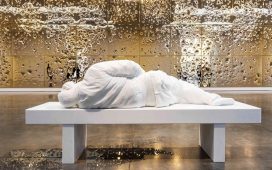In the exhibition Jason and the Adventure of 254, there’s a sculpture of runner Sebastian Coe’s body with a TV for a head. This freezes in time the moment that the artist Jason Wilsher-Mills was diagnosed with an auto-immune condition: at 2:54pm at Pinderfields hospital in Wakefield, West Yorkshire, while watching Coe win a gold medal in the 1500m race at the 1980 Moscow Olympics.
Wilsher-Mills would spend the next five years paralysed from the neck down due to polyneuropathy and chronic fatigue syndrome, diseases that affect mobility and attack the immune system. In the centre of the show at London’s Wellcome Collection is a vast sculpture of the artist as a child in a hospital bed, as toy soldiers move towards his body – a metaphor that doctors used to explain to him that his white blood cells were attacking, rather than defending, his own body.
In 1980, social workers often pushed for disabled people to be placed into care homes, something his “tigress’” mother fiercely resisted. Wilsher-Mills depicts her in one of the show’s dioramas: Mum as a Mermaid, in which she swims with a fish that holds itself up on crutches. Another scene shows the artist and his sister at the beach with bacteria on the horizon, an omen of what’s to come, while a third called Uncle Dennis and the Inseminoids is inspired by a memory of his uncle telling him about a horror film he’d seen while visiting him in hospital.
Wilsher-Mills was brought up in Wakefield, the youngest of eight children. His father was a miner until he got pneumoconiosis from breathing in coal dust. His childhood, the artist says on a video call, meant that he learned about politics “hands on; going to miners’ galas, becoming disabled in the international year of the disabled; mum and dad fighting for me not to go into care. If you’re disabled, you’re a political being.”
Like much of Wilsher-Mills’ work, Jason and the Adventure of 254 has a vivid, comic-strip aesthetic that the artist compares to the Beano. He calls his work “Trojan Horse art” and “proletariat burlesque”, meaning that he uses larger-than-life visuals and a disarming sense of humour to sneak in political messages about life as a person with a disability. His condition is progressive and he still uses a wheelchair. Drawing is tough as his tendons have been damaged, so Wilsher-Mills uses an iPad. But 254 also contains new, hand-drawn work, a response to the Wellcome Collection’s archive being made open to him. “It poured out of me,” he says. “They showed me stuff, and they gave me some paper and a pencil, and I drew.” He admits that, although his hands aren’t great, and he’s waiting for his shoulders to be rebuilt, he couldn’t stop himself, and that in the process he “went back to being a kid”.
In 2015, Wilsher-Mills was commissioned by the House of Commons to create the artwork The 1995 Disability Discrimination Act. He decided to commemorate an incident from 1981, when he was wheeled six miles from the hospital by his brother to see a double-bill of Jaws and Jaws 2, only to be told by the cinema manager that his wheelchair made him a fire hazard. The artist says that his brother Michael left him in the care of friends so he could “have a word” with the manager. “I think Michael believed in direct action,” he laughs. The story is hidden in a small panel, with Jaws on the screen as a fire extinguisher is thrown through the air, in what Wilsher-Mills calls “a little act of subversion in the Houses of Parliament”.
There are echoes of this work in another of the dioramas calledPainting With My Mouth, showing the artist attempting to paint a pinup with a brush in his teeth, while surrounded by images that have appeared elsewhere in the exhibition, in reference to the 1875 Robert W Buss etching Dickens’s Dream. Wilsher-Mills says that reading Great Expectations was a vital formative influence. “It’s a bit shameful really, but I really identified with Pip because I wanted to be a gentleman, just like Pip. I wanted to get away from the foundry.”
But if 254 shows anything, it’s the love and support Wilsher-Mills got from his family. When he was young, his mum told him “we’re gonna save up and send you to Paris, ’cos that’s where the artists are.” It also speaks to the power of art to provide solace and inspiration. When John Lennon was shot in December 1980, Wilsher-Mills heard Strawberry Fields Forever for the first time. “I hope that adults, but particularly kids, will come along to the show, and they’ll rejoice in the joy of it,” he says. “That they will see a kindred spirit, like I did when I heard that music, and they will think: I’m not alone.”
after newsletter promotion








